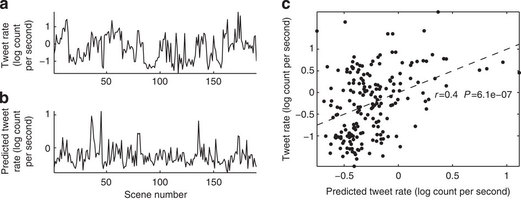Marketing experts have long wanted a reliable method of forecasting responses to products and messages.
A study that analyzed the brain responses of 16 individuals says even a few people can be a remarkably strong predictor of the preferences of large TV audiences, up to 90 percent in the case of Super Bowl commercials.
This is far superior to the wobbly claims made by psychology surveys.

Neural reliability predicts scene-by-scene tweet frequency. a) Log frequency of tweets related to each scene (N=190) of a popular television broadcast. (b) Log tweet frequency as predicted from the scene-by-scene neural reliability measured across 16 participants during subsequent viewing of the episode in the laboratory (see equation (4) in Methods). (c) Neural reliability explains 16% of the variance in the log tweet rate (r=0.4, P=6.1 × 10−7, N=190; 95% confidence interval on r: (0.26,0.51)). Dashed line represents regression from predicted to actual log tweet rate. Credit:
doi:10.1038/ncomms5567
"Alternative methods such as self-reports are fraught with problems as people conform their responses to their own values and expectations," said Dr. Jacek Dmochowski, lead author of the paper. However, brain signals measured using electroencephalography (EEG) can, in principle, alleviate this shortcoming by providing immediate physiological responses immune to such self-biasing. "Our findings show that these immediate responses are in fact closely tied to the subsequent behavior of the general population," he added.
Lucas Parra, a Professor of Biomedical Engineering at CCNY and the paper's senior author explained that, "when two people watch a video, their brains respond similarly – but only if the video is engaging. Popular shows and commercials draw our attention and make our brainwaves very reliable; the audience is literally 'in-sync'."
In the study, participants watched scenes from "The Walking Dead" TV show and several commercials from the 2012 and 2013 Super Bowls. EEG electrodes were placed on their heads to capture brain activity. The reliability of the recorded neural activity was then compared to audience reactions in the general population using publicly available social media data provided by the Harmony Institute and ratings from USA Today's Super Bowl Ad Meter.
"Brain activity among our participants watching "The Walking Dead" predicted 40 percent of the associated Twitter traffic," said Parra. "When brainwaves were in agreement, the number of tweets tended to increase." Brainwaves also predicted 60 percent of the Nielsen ratings that measure the size of a TV audience.
The study was even more accurate (90 percent) when comparing preferences for Super Bowl ads. For instance, researchers saw very similar brainwaves from their participants as they watched a 2012 Budweiser commercial that featured a beer-fetching dog. The general public voted the ad as their second favorite that year. The study found little agreement in the brain activity among participants when watching a GoDaddy commercial featuring a kissing couple. It was among the worst rated ads in 2012.
Using functional magnetic resonance imaging (fMRI), they found evidence that brainwaves for engaging ads could be driven by activity in visual, auditory and attention brain areas.
"Interesting ads may draw our attention and cause deeper sensory processing of the content," said co-author Dr. Matthew Bezdek of Georgia Tech's School of Psychology.





Comments